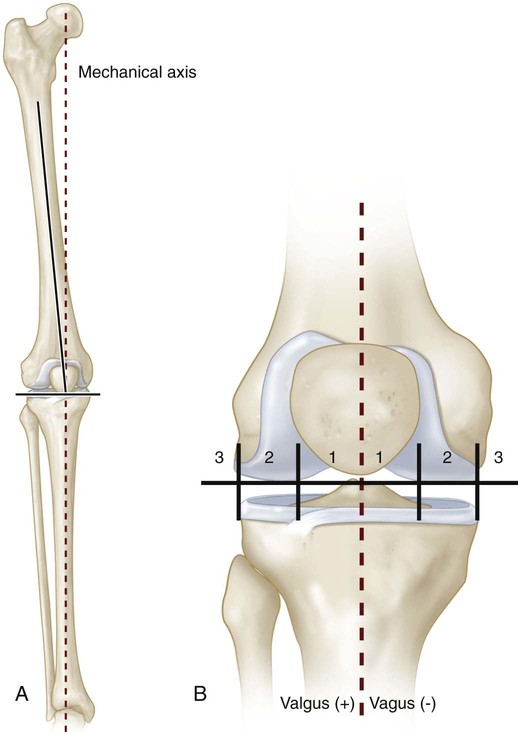• Figure 3A demonstrates a 12-year-old female presenting with unilateral Blount disease, including lateral ligamentous laxity and thrust. There is no concomitant femoral valgus or varus deformity. • Twelve months following guided growth of the tibia, her mechanical axis is neutral, the lateral laxity and thrust are resolved, and the 8-plate was removed (Fig. 3B).
Guided Growth—Hemiepiphysiodesis
Indications
 Any angular deformity of the extremities, as long as the physis is still open
Any angular deformity of the extremities, as long as the physis is still open
 Any etiology: posttraumatic, developmental, metabolic, genetic, dysplasias, neuromuscular etc.
Any etiology: posttraumatic, developmental, metabolic, genetic, dysplasias, neuromuscular etc.
 Guided growth is the most recent and refined treatment available. Reversible in nature, the 8-plate is removed upon achievement of the desired neutral alignment.
Guided growth is the most recent and refined treatment available. Reversible in nature, the 8-plate is removed upon achievement of the desired neutral alignment.
 The most common application for guided growth is for correction of frontal plane deformities of the knee. However, it is also useful for oblique or sagittal deformities as well as for ankle deformities. Metabolic, dysplastic, or congenital deformities are not a contraindication to guided growth. In fact, by restoring the mechanical axis and correcting gait abnormalities (such as waddling or circumduction), the physes are spared cumulative damage and may actually respond surprisingly well.
The most common application for guided growth is for correction of frontal plane deformities of the knee. However, it is also useful for oblique or sagittal deformities as well as for ankle deformities. Metabolic, dysplastic, or congenital deformities are not a contraindication to guided growth. In fact, by restoring the mechanical axis and correcting gait abnormalities (such as waddling or circumduction), the physes are spared cumulative damage and may actually respond surprisingly well.
Examination/Imaging
 A full-length anteroposterior (AP) standing teloroentgenogram of the legs is obtained with the patellae facing forward and the pelvis leveled as needed with a block under the foot of the shorter leg (Fig. 1). The other side is properly positioned with the patella neutral.
A full-length anteroposterior (AP) standing teloroentgenogram of the legs is obtained with the patellae facing forward and the pelvis leveled as needed with a block under the foot of the shorter leg (Fig. 1). The other side is properly positioned with the patella neutral.

 On this frontal projection, the mechanical axis should bisect the knee, or at least fall within the central two quadrants (Fig. 2A). Dividing the knee into quadrants, the mechanical axis should fall within the central two quadrants (± zone 1). Zones 2 and 3 represent indications for guided growth to restore the axis to (or slightly past) neutral (Fig. 2B).
On this frontal projection, the mechanical axis should bisect the knee, or at least fall within the central two quadrants (Fig. 2A). Dividing the knee into quadrants, the mechanical axis should fall within the central two quadrants (± zone 1). Zones 2 and 3 represent indications for guided growth to restore the axis to (or slightly past) neutral (Fig. 2B).

 Also, AP and lateral views of the hip, knee, or ankle are obtained to see the details of the physes of interest.
Also, AP and lateral views of the hip, knee, or ankle are obtained to see the details of the physes of interest.

 Fluoroscopic views orthogonal to the physis (such as in Blount disease) may be obtained to rule out a physeal bar.
Fluoroscopic views orthogonal to the physis (such as in Blount disease) may be obtained to rule out a physeal bar.
 An intraoperative arthrogram (in young children) may be obtained to outline the chondroepiphyses and facilitate targeting/postition of implants.
An intraoperative arthrogram (in young children) may be obtained to outline the chondroepiphyses and facilitate targeting/postition of implants.
22: Guided Growth—Hemiepiphysiodesis





